Why Mandu in Madhya Pradesh Is India’s Forgotten City of Love
Gurjeet Kaur | Apr 11, 2025, 20:43 IST
Mandu
( Image credit : Times Life Bureau )
Mandavgad, fondly known as Mandu, is a timeless treasure nestled in Madhya Pradesh’s Malwa region, where history and romance intertwine. This hidden gem, perched atop the Vindhya hills, whispers tales of its glorious past through crumbling palaces and majestic monuments. At its heart lies the legendary love story of Sultan Baz Bahadur and Rani Roopmati—a tale of passion, music, and tragedy. Enchanted by Roopmati’s divine voice, Baz Bahadur built her a pavilion to gaze upon the sacred Narmada River, only for their love to be shattered by Mughal conquest.
Nestled in the heart of Madhya Pradesh, Mandav (also known as Mandu or Mandavgad) is a place where history, romance, and nature weave a magical tapestry. Perched on the Vindhya Range at an altitude of about 2,000 feet, this ancient fort city is surrounded by lush greenery, deep ravines, and breathtaking landscapes. Often called the "City of Joy" or Shadiabad, Mandav is a treasure trove of architectural marvels, scenic beauty, and timeless stories that captivate every visitor. Its palaces, mosques, and pavilions stand as silent witnesses to a glorious past, while its serene ambiance offers a peaceful escape from the hustle of modern life. In this article, we’ll explore why Mandav is a must-visit destination, delve into its beauty, and share the legendary love story that adds to its charm.
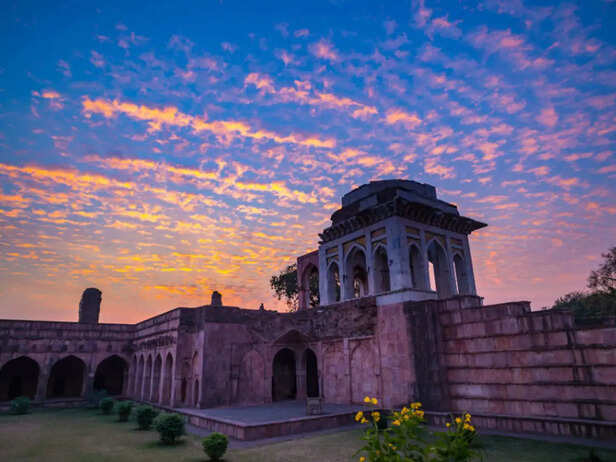
Mandav’s beauty lies in its perfect blend of natural splendor and architectural brilliance. The city is situated on a rocky plateau, separated from the Malwa region by a deep gorge called Kakda Kho. This dramatic setting gives Mandav a unique character—rugged yet serene, ancient yet alive. During the monsoon, the landscape transforms into a lush green paradise, with waterfalls like Kakda Kho cascading down cliffs, adding a refreshing charm to the ruins.
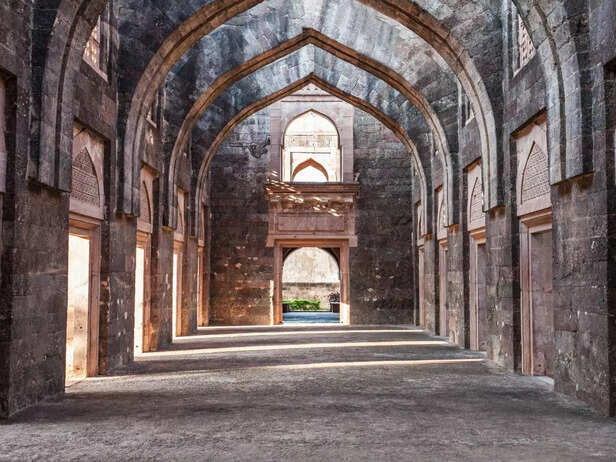
The city is dotted with monuments that showcase a fusion of Afghan, Mughal, and Rajput styles. One of the most iconic structures is the Jahaz Mahal, which appears to float between two lakes, Munj Talao and Kapur Talao. Its unique design, with open courtyards and arched corridors, reflects the ingenuity of its builders. The Hindola Mahal, also called Swinging Palace, is gem. It was named Hindola Mahal for its sloping walls. it give the illusion of swaying. Its simple yet striking design leaves visitors in awe of its engineering. Rani Roopmati Pavilion is perched on a hilltop, offers panoramic views of the Narmada. This romantic spot is not just a visual delight but also a place steeped in emotion, tied to the love story of Baz Bahadur and Roopmati.
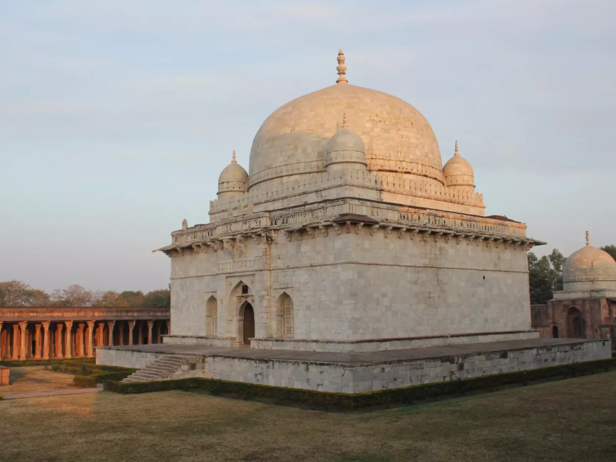
The Jami Masjid, with grand arches, stands as Mandav’s rich Islamic heritage, while the Hoshang Shah’s Tomb, considered India’s first marble mausoleum, inspired later monuments like the Taj Mahal. Commissioned by Hoshang Shah in 1440, the tomb features Afghan and Hindu architectural elements, with intricate geometric designs and lotus motifs. Its central sarcophagus, shaped like a casket, is a highlight. Shah Jahan’s architects studied it before designing the Taj Mahal, suggesting its influence. Located near Jami Masjid, it remains a well-preserved example of early marble craftsmanship.
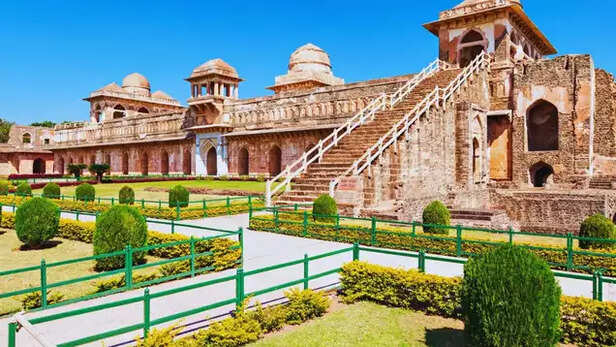
Beyond the monuments, Mandav’s natural beauty is equally captivating. The city is surrounded by baobab trees, originally brought from Africa, which add an exotic touch to the landscape. The Rewa Kund, a sacred water tank, reflects the surrounding ruins, creating a serene and almost mystical atmosphere. Walking through Mandav feels like stepping into a painting, where every corner reveals a new shade of beauty—whether it’s the golden hues of sunset over the palaces or the mist that blankets the ravines in the early morning.
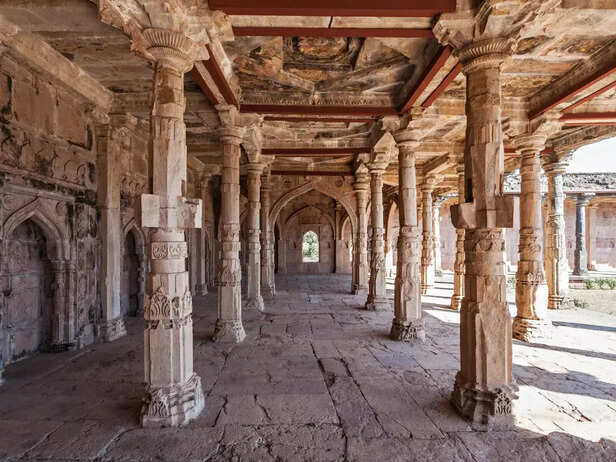
Mandav visit is incomplete without knowing the love story of Baz Bahadur and Rani Roopmati.
Mandav's last independent ruler Baz Bahadur, was a poet and musician too. he loved the arts. During a hunting expedition, he heard the melodious voice of Roopmati, a beautiful shepherdess and talented singer from the Malwa region. Captivated by her voice and grace, Baz Bahadur fell deeply in love.
Roopmati, equally enchanted by the prince, agreed to join him in Mandav, but on one condition—she must always be able to see her beloved Narmada River, which she revered. To fulfill her wish, Baz Bahadur built the Roopmati Pavilion on a hilltop, offering her a clear view of the river winding through the plains below. The couple spent their days immersed in music, poetry, and love, creating a golden era of art and culture in Mandav.
However, their happiness was short-lived. The Mughal emperor Akbar, seeking to expand his empire, sent his general Adham Khan to conquer Mandav. Baz Bahadur was defeated In the battle and forced to flee. Heartbroken and unwilling to live without her beloved, Roopmati poisoned herself. The lovers were never reunited, but their story lives in the Malwa and the stones of Mandav.
Mandav is more than just a historical site; it’s an experience that touches the soul. Here are some reasons why you should Mandav .
Mandav’s monuments take you back to the 15th and 16th centuries, offering a glimpse into the lives of kings, poets, and warriors. Each structure tells a story, from the grandeur of the sultans to the devotion of the artisans who built them. For history lovers, it’s like walking through a living museum.
Mandav’s lush greenery, waterfalls, and scenic viewpoints offer a refreshing escape. The monsoon season, in particular, transforms the city into a vibrant canvas of green, making it ideal for nature lovers and photographers.
Unlike crowded tourist destinations, Mandav retains a quiet, almost untouched charm. It’s a place where you can wander through ruins, listen to the wind, and feel a deep sense of calm.
Mandav’s festivals, like the Mandu Festival held in September or October, celebrate its art, music, and cuisine. Sampling local Malwa dishes like dal paniya or exploring handicraft markets adds a cultural flavor to your visit.
Located just 98 km from Indore, Mandav is easily reachable by road. The nearest airport and railway station in Indore make it convenient for travelers from across India.
Mandav is not just a destination; it’s a feeling. It’s the thrill of discovering a hidden gem, the awe of standing before centuries-old palaces, and the bittersweet pang of a love story that never fades. Whether you’re a history buff, a nature enthusiast, or simply someone seeking beauty and peace, Mandav has something to offer. The city’s ability to blend the past with the present, the grand with the intimate, makes it a place that lingers in your heart long after you leave.
So, pack your bags and head to Mandav. Let its beauty enchant you, its stories inspire you, and its serenity recharge you. In the heart of Madhya Pradesh, this "City of Joy" awaits to share its magic with you.
Explore the latest trends and tips in Health & Fitness, Travel, Life Hacks, Fashion & Beauty, and Relationships at Times Life!
1. The Beauty of Mandav

Mandav
( Image credit : Times Life Bureau )
Mandav’s beauty lies in its perfect blend of natural splendor and architectural brilliance. The city is situated on a rocky plateau, separated from the Malwa region by a deep gorge called Kakda Kho. This dramatic setting gives Mandav a unique character—rugged yet serene, ancient yet alive. During the monsoon, the landscape transforms into a lush green paradise, with waterfalls like Kakda Kho cascading down cliffs, adding a refreshing charm to the ruins.
2. Mandu’s Monuments

Visit Mandav
( Image credit : Times Life Bureau )
The city is dotted with monuments that showcase a fusion of Afghan, Mughal, and Rajput styles. One of the most iconic structures is the Jahaz Mahal, which appears to float between two lakes, Munj Talao and Kapur Talao. Its unique design, with open courtyards and arched corridors, reflects the ingenuity of its builders. The Hindola Mahal, also called Swinging Palace, is gem. It was named Hindola Mahal for its sloping walls. it give the illusion of swaying. Its simple yet striking design leaves visitors in awe of its engineering. Rani Roopmati Pavilion is perched on a hilltop, offers panoramic views of the Narmada. This romantic spot is not just a visual delight but also a place steeped in emotion, tied to the love story of Baz Bahadur and Roopmati.
3. India’s First Marble Mausoleum

Marble Mausoleum
( Image credit : Times Life Bureau )
The Jami Masjid, with grand arches, stands as Mandav’s rich Islamic heritage, while the Hoshang Shah’s Tomb, considered India’s first marble mausoleum, inspired later monuments like the Taj Mahal. Commissioned by Hoshang Shah in 1440, the tomb features Afghan and Hindu architectural elements, with intricate geometric designs and lotus motifs. Its central sarcophagus, shaped like a casket, is a highlight. Shah Jahan’s architects studied it before designing the Taj Mahal, suggesting its influence. Located near Jami Masjid, it remains a well-preserved example of early marble craftsmanship.
4. City Is Surrounded By Baobab Trees

Mandu Architecture
( Image credit : Times Life Bureau )
Beyond the monuments, Mandav’s natural beauty is equally captivating. The city is surrounded by baobab trees, originally brought from Africa, which add an exotic touch to the landscape. The Rewa Kund, a sacred water tank, reflects the surrounding ruins, creating a serene and almost mystical atmosphere. Walking through Mandav feels like stepping into a painting, where every corner reveals a new shade of beauty—whether it’s the golden hues of sunset over the palaces or the mist that blankets the ravines in the early morning.
5. Love Story of Baz Bahadur and Roopmati:

MP's Mandu
( Image credit : Times Life Bureau )
Mandav visit is incomplete without knowing the love story of Baz Bahadur and Rani Roopmati.
Mandav's last independent ruler Baz Bahadur, was a poet and musician too. he loved the arts. During a hunting expedition, he heard the melodious voice of Roopmati, a beautiful shepherdess and talented singer from the Malwa region. Captivated by her voice and grace, Baz Bahadur fell deeply in love.
Roopmati, equally enchanted by the prince, agreed to join him in Mandav, but on one condition—she must always be able to see her beloved Narmada River, which she revered. To fulfill her wish, Baz Bahadur built the Roopmati Pavilion on a hilltop, offering her a clear view of the river winding through the plains below. The couple spent their days immersed in music, poetry, and love, creating a golden era of art and culture in Mandav.
However, their happiness was short-lived. The Mughal emperor Akbar, seeking to expand his empire, sent his general Adham Khan to conquer Mandav. Baz Bahadur was defeated In the battle and forced to flee. Heartbroken and unwilling to live without her beloved, Roopmati poisoned herself. The lovers were never reunited, but their story lives in the Malwa and the stones of Mandav.
6. Why You Must Visit Mandav
A Journey Through History:
Nature’s Embrace:
Peace and Serenity:
Cultural Richness:
Easy Accessibility:
A Place That Stays With You
So, pack your bags and head to Mandav. Let its beauty enchant you, its stories inspire you, and its serenity recharge you. In the heart of Madhya Pradesh, this "City of Joy" awaits to share its magic with you.
Explore the latest trends and tips in Health & Fitness, Travel, Life Hacks, Fashion & Beauty, and Relationships at Times Life!
